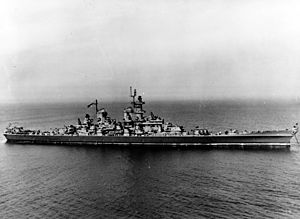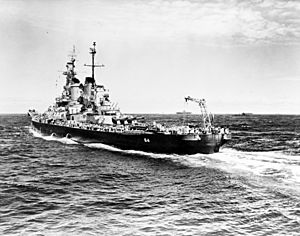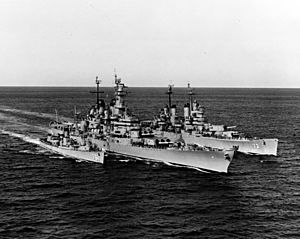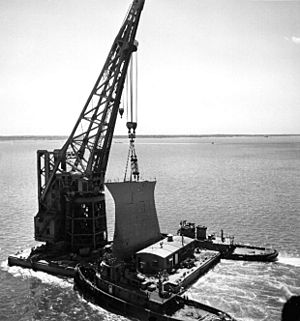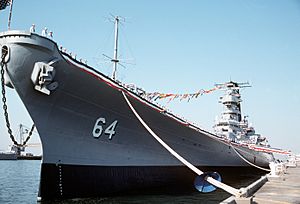USS Wisconsin (BB-64) facts for kids
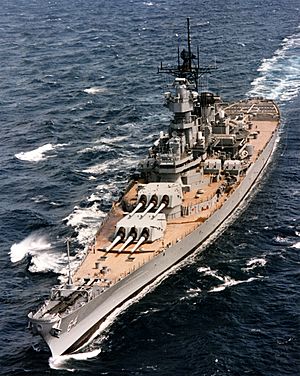
Wisconsin at sea, c. 1990
|
|
Quick facts for kids History |
|
|---|---|
| Namesake | State of Wisconsin |
| Ordered | 12 June 1940 |
| Builder | Philadelphia Naval Shipyard |
| Laid down | 25 January 1941 |
| Launched | 7 December 1943 |
| Commissioned | 16 April 1944 |
| Decommissioned | 1 July 1948 |
| Recommissioned | 3 March 1951 |
| Decommissioned | 8 March 1958 |
| Recommissioned | 22 October 1988 |
| Decommissioned | 30 September 1991 |
| Stricken | 17 March 2006 |
| Identification | Hull number: BB-64 |
| Motto | "Forward for Freedom" |
| Nickname(s) | "Big Wisky" |
| Honors and awards |
6 Battle Stars |
| Status | Museum ship at Nauticus |
| Badge |  |
| General characteristics (as built) | |
| Class and type | Iowa-class battleship |
| Displacement | 57,216 long tons (58,134 t) (full load) |
| Length | 887 ft 3 in (270.4 m) (o/a) |
| Beam | 108 ft 2 in (33 m) |
| Draft | 37 ft 9 in (11.5 m) (full load) |
| Installed power |
|
| Propulsion |
|
| Speed | 32.5 knots (60.2 km/h; 37.4 mph) |
| Range | 15,000 nmi (28,000 km; 17,000 mi) at 15 knots (28 km/h; 17 mph) |
| Complement | 117 officers, 1,804 enlisted men (designed) |
| Sensors and processing systems |
|
| Armament |
|
| Armor |
|
| General characteristics (1988) | |
| Complement | 1,515 officers and enlisted men |
| Sensors and processing systems |
|
| Electronic warfare & decoys |
|
| Armament |
|
|
USS Wisconsin (BB-64)
|
|
| Location | 1 Waterside Dr., Norfolk, Virginia |
| Built | 1941 |
| Architect | Bureau of Construction and Repair |
| Architectural style | Iowa-class battleship |
| NRHP reference No. | 12000178 |
| Significant dates | |
| Added to NRHP | 28 March 2012 |
The USS Wisconsin (BB-64) is a famous battleship that served in the United States Navy. It was built in the 1940s and is now a museum ship that people can visit. This powerful ship played important roles in World War II, the Korean War, and even the Gulf War.
Wisconsin was first put into service in 1944. It sailed to the Pacific Ocean during World War II, helping in major battles like Iwo Jima and Okinawa. After the war, it helped shell targets in Japan.
Later, during the Korean War, Wisconsin used its big guns to support ground troops. It was taken out of service for a while but brought back in 1986. After getting modern upgrades, it joined Operation Desert Storm in 1991.
Wisconsin was officially taken out of service for the last time in 1991. It served for 14 years in total. During its time, it earned six battle stars for its service. Today, the Wisconsin is a museum ship in Norfolk, Virginia, where visitors can explore its history.
Contents
Building a Mighty Ship
The Iowa class of battleships, which Wisconsin belongs to, was designed in the late 1930s. These were the last battleships built by the United States. They were also the largest and fastest battleships the US Navy ever had.
Wisconsin is very long, about 887 feet (270 meters) from end to end. It is powered by four steam turbines, which use steam from eight boilers. These engines gave the ship a top speed of about 32.5 knots (about 37 miles per hour).
The ship was designed to carry a crew of about 117 officers and 1,804 sailors. By the end of World War II, its crew grew to 173 officers and 2,738 sailors.
Powerful Weapons and Protection
The main weapons on Wisconsin were nine huge 16-inch (406 mm) guns. These were placed in three turrets, with two at the front and one at the back. It also had twenty 5-inch (127 mm) guns for other targets.
For defense against aircraft, it had many 40 mm and 20 mm anti-aircraft guns. These guns helped protect the ship from enemy planes.
The Wisconsin was built with very strong armor to protect it from attacks. Its side armor belt was over 12 inches (30 cm) thick. The turrets holding the main guns had armor almost 20 inches (50 cm) thick. This heavy armor made it very tough in battle.
The ship also had a special system to protect it from torpedoes. This system used several watertight compartments to absorb the blast of an underwater explosion.
Construction and Launch
Wisconsin was the second US Navy ship named after the state of Wisconsin. It was ordered in 1940 and its construction began in 1941 at the Philadelphia Naval Shipyard.
The ship was launched on December 7, 1943. It was officially put into service on April 16, 1944. Interestingly, Wisconsin was commissioned before its sister ship Missouri, even though Missouri's construction started earlier.
World War II Adventures (1944–1945)
After its first tests and training, Wisconsin left Norfolk, Virginia, in July 1944. It sailed to the Pacific Ocean to join the war effort. Its main job was to protect aircraft carriers from enemy planes.
Facing a Typhoon
In December 1944, while refueling in the Philippine Sea, Wisconsin and its task force were hit by Typhoon Cobra. This powerful storm sank three destroyers and damaged many other ships. Wisconsin was not badly damaged, but two sailors were injured.
Attacks on Japan
In January 1945, Wisconsin helped attack Japanese airfields in Taiwan and Okinawa. These attacks were important to clear the way for American landings on Luzon Island in the Philippines.
The ship continued to protect carriers as they launched air raids on places like Hong Kong and Canton. These missions helped weaken Japanese forces.
In March 1945, Wisconsin joined other battleships to bombard targets on Okinawa. This was a trick to make the Japanese think the landings would happen there.
Later, in July 1945, Wisconsin and its sister ships bombarded industrial targets in Japan. They hit steel factories and other important sites. These attacks helped pressure Japan to surrender.
World War II ended on August 15, 1945. Wisconsin arrived in Tokyo Bay in September as part of the occupying forces. During the war, it traveled over 105,000 miles and helped shoot down enemy planes.
Coming Home
After the war, Wisconsin helped bring American soldiers, sailors, and marines home from the Pacific. This was part of Operation Magic Carpet. It reached San Francisco in October 1945.
For a while, Wisconsin served as a training ship for naval reservists and midshipmen. It visited various ports in South America and Europe. In 1948, it was taken out of service and put into the reserve fleet.
Korean War Service (1950–1952)
Wisconsin's time in reserve was short. When the Korean War began in 1950, it was brought back into service in March 1951. After training, it sailed to the Pacific.
In November 1951, Wisconsin arrived in Yokosuka, Japan, and became the flagship for the 7th Fleet. It then headed to Korean waters to support the war effort.
Supporting Ground Troops
From December 1951, Wisconsin provided powerful gunfire support for ground troops in Korea. It shelled enemy tanks, gun positions, and troop areas. Its big guns were very effective in helping the soldiers on land.
One time, it fired special star-shells to light up an enemy attack at night. This helped the South Korean troops push back the enemy.
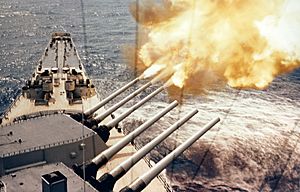
Wisconsin continued its missions, hitting enemy bunkers, command posts, and railway targets. In March 1952, it was hit by a North Korean shell, but the damage was minor, and it quickly destroyed the enemy battery.
After its service in Korea, Wisconsin returned to the United States in April 1952. It had played a crucial role in supporting the United Nations forces.
After Korea and Reactivation (1952–1990)
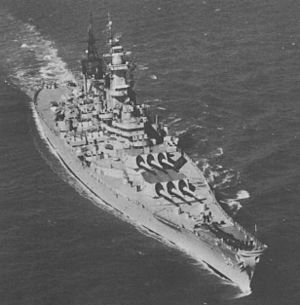
After the Korean War, Wisconsin continued to serve as a training ship. It took midshipmen on cruises to places like Scotland and France. It also participated in NATO exercises.
Collision and Repairs
In May 1956, Wisconsin was involved in a collision with the destroyer Eaton in heavy fog. Wisconsin's bow was badly damaged.
To fix it quickly, a 68-foot (21-meter) section of the bow from its unfinished sister ship, Kentucky, was used. This new bow was attached in just 16 days, allowing Wisconsin to continue its training schedule.
Wisconsin was taken out of service again in March 1958. It joined the "mothball fleet" in Bayonne, New Jersey, and later moved to the Philadelphia Naval Shipyard.
Modern Upgrades
In 1986, as part of President Ronald Reagan's plan for a larger navy, Wisconsin was reactivated. It was towed to shipyards for major upgrades.
All its old anti-aircraft guns were removed. New, advanced weapons were installed, including Tomahawk cruise missiles and Harpoon anti-ship missiles. It also received modern radar and fire control systems.
Wisconsin was recommissioned on October 22, 1988. It became the main ship of its own battle group, based in Naval Station Norfolk, Virginia.
Gulf War Service (1991)
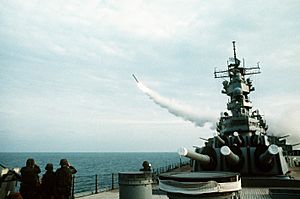
In August 1990, Iraq invaded Kuwait. Wisconsin and its battle group were sent to the Persian Gulf to help. In January 1991, Operation Desert Storm began.
Wisconsin and its sister ship Missouri launched Tomahawk missiles against targets in Iraq. Wisconsin was in charge of directing many of these missile launches.
Combat Missions
In February 1991, Wisconsin used its big guns to destroy an Iraqi artillery battery in Kuwait. It also used a drone aircraft to spot targets for its guns. This was the first time a drone was used this way in combat.
The ship pounded Iraqi communication centers, missile sites, and naval targets. It severely damaged or sank 15 Iraqi boats.
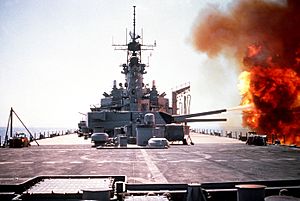
On February 23, Wisconsin and Missouri shelled Faylaka Island to trick Iraqi forces. During this mission, Wisconsin's drone flew over Iraqi positions. The Iraqi soldiers, seeing the drone and remembering the battleship's powerful guns, began waving white flags to surrender! This was the first time enemy troops surrendered to an unmanned aircraft controlled by a ship.
By the end of the war on February 28, Wisconsin had fired over a million pounds of ammunition at Iraqi targets. It fired the last naval gunfire support mission of the war, making it the last battleship in history to see action.
A Museum Ship Today (1992–Present)
After the Gulf War, the cost of keeping battleships active was too high. Wisconsin was decommissioned on September 30, 1991. It had served a total of 14 years.
In 2000, Wisconsin was moved to Nauticus, The National Maritime Center in Norfolk, Virginia. In 2001, its decks were opened to the public as a museum.
For a while, Congress required Wisconsin to be kept ready in case it was needed again. This meant it had to be preserved and its equipment maintained.
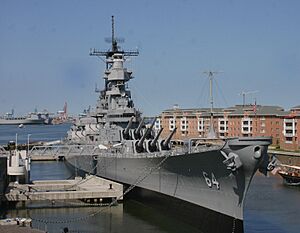
However, on December 14, 2009, the US Navy officially gave Wisconsin to the city of Norfolk. This ended the requirement for it to be ready for active duty. A special ceremony took place on April 16, 2010.
Today, the USS Wisconsin is a popular museum ship. Visitors can explore its decks and learn about its amazing history. It was added to the National Register of Historic Places in 2012.
Awards and Honors
Wisconsin earned many awards for its service. It received five battle stars for World War II and one for the Korean War. It also earned the Combat Action Ribbon and the Navy Unit Commendation for its actions in the Korean War and the Gulf War.
|
|
||
| Combat Action Ribbon w/ 1 award star | Navy Unit Commendation | ||||
| American Campaign Medal | Asiatic-Pacific Campaign Medal w/ 5 battle stars | World War II Victory Medal | |||
| Navy Occupation Service Medal | National Defense Service Medal w/ 1 service star | Korean Service Medal w/ 1 battle star | |||
| Southwest Asia Service Medal w/ 2 service stars | Navy Sea Service Deployment Ribbon | Philippine Presidential Unit Citation | |||
| Korean Presidential Unit Citation | Philippine Liberation Medal w/ 2 service stars | United Nations Korea Medal | |||
| Kuwait Liberation Medal (Saudi Arabia) | Kuwait Liberation Medal (Kuwait) | Korean War Service Medal | |||
See also
 In Spanish: USS Wisconsin (BB-64) para niños
In Spanish: USS Wisconsin (BB-64) para niños
- List of museum ships
- U.S. Navy museums




